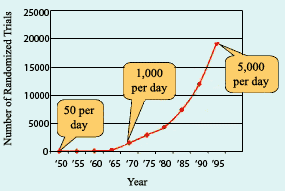
Why Is EBM Important? (1 of 2)
“My students are dismayed when I say to them ‘Half of what you are taught as medical students will in ten years have been shown to be wrong. And the trouble is, none of your teachers know which half.’”
---- Dr. Sydney Burwell, Dean of Harvard Medical School, 1956 (Quote in Pickering GW. BMJ 1956; 2:113)
The number of journal articles published about randomized, controlled trials is increasing at an exponential rate:

- According to the Oxford Center for Evidence-Based Medicine, physicians who want to keep abreast of their particular field would need to review 19 articles per day, 365 days per year.
- This is neither practical nor realistic.
- Other tools and strategies are necessary.
- “Less than 10% of the articles that are published
in the core medical journals are both high quality and clinically
useful.”
(Guyatt, Gordon and Rennie, Drummond (eds.). Users' guides to the medical literature: a manual for evidence-based clinical practice. The Evidence-Based Medicine Working Group; Chicago, IL: AMA Press, c2002) - Also, much of the published literature is just plain wrong!
- A good example of this is with regard to the use of
hormone replacement therapy (HRT) in post menopausal women used to
reduce the risk of coronary heart disease (CHD):
- A meta-analysis of 16 cohort studies and 3 cross-sectional angiography studies gave a relative risk of 0.5 (50% reduction) for coronary disease among estrogen users. “The evidence strongly suggests that women who take postmenopausal estrogen are at decreased risk of CHD.”
- A much higher quality study was done later, The Women's
Health Initiative. (JAMA 2002; 288:321): This study showed that women
who received HRT had more total cardiovascular disease (CVD) than
those who received placebo, including CHD (mainly nonfatal MI), stroke,
and venous thromboembolism. This was a completely opposite finding
than all the previous literature and radically changed the way HRT
is used in medical practice.